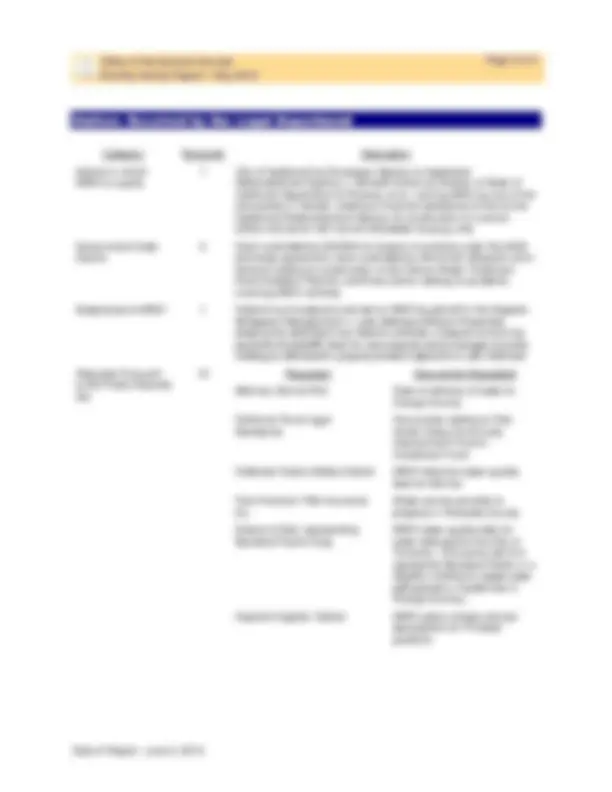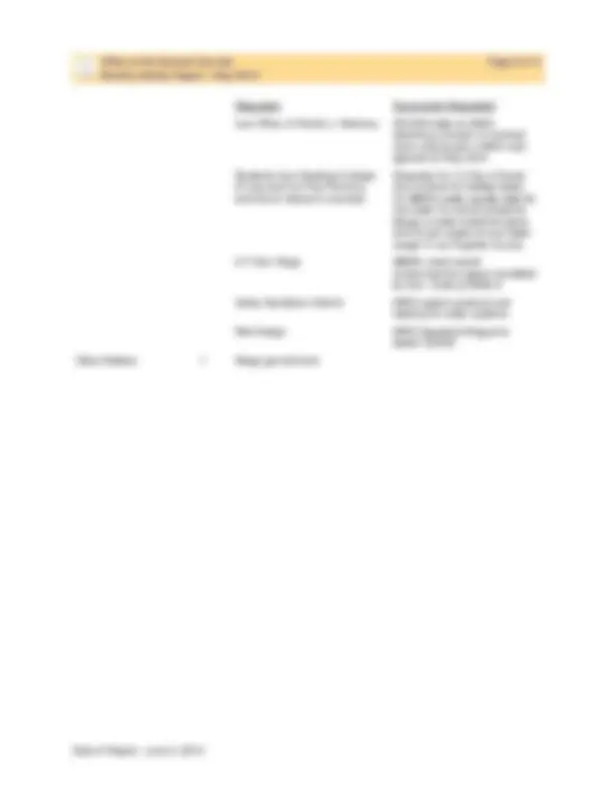




Study with the several resources on Docsity

Earn points by helping other students or get them with a premium plan


Prepare for your exams
Study with the several resources on Docsity

Earn points to download
Earn points by helping other students or get them with a premium plan
Community
Ask the community for help and clear up your study doubts
Discover the best universities in your country according to Docsity users
Free resources
Download our free guides on studying techniques, anxiety management strategies, and thesis advice from Docsity tutors
A monthly activity report from the office of the general counsel of the metropolitan water district of southern california for may 2014. The report covers various cases involving the district, including settlements, litigations, and regulatory matters. Notable cases include tronox, inc. V. Kerr mcgee corp., matters involving metropolitan sacramento regional county sanitation district, and property reserve, inc. V. Superior court. The report also includes updates on the bay delta conservation plan and new maximum contaminant level for hexavalent chromium.
What you will learn
Typology: Study notes
1 / 4

This page cannot be seen from the preview
Don't miss anything!



Metropolitan Water District of Southern California
Tronox, Inc. v. Kerr McGee Corp. (U.S. Bankruptcy Court, Southern District of New York)
On May 28, 2014, a New York bankruptcy judge approved the proposed settlement of $5.15 billion in the Tronox Inc. v. Kerr McGee Corp. adversary proceeding (Adversary Action). The public comment period for the settlement closed on May 21, 2014. The deadline to object to the settlement was May 15. Several groups filed objections to the settlement, including the AIG Parties. The AIG Parties comprised of insurance companies, asked that the settlement agreement and any order approving the settlement preserve the AIG Parties’ right to seek reimbursement from the settlement proceeds of $257 million disbursed on behalf of its insureds (including the Nevada Environmental Response Trust (Trust)). Before
the May 28 hearing, AIG agreed to dismiss its objection in exchange for a clarification that the agreement does not affect the rights of the parties.
In response to objections from claimants in Columbus, Mississippi, the judge pointed out that many of the claimants had failed to file a claim in the bankruptcy proceeding and that the settlement would delay cleanup. Accordingly, the judge will recommend that the federal district court approve the settlement. Payment will be made after court approval of the settlement is final and no longer appealable, which is expected to be by fall of 2014. If the settlement is approved, the Trust will receive approximately $1.1 billion from the settlement, which will be used to clean up the Tronox site in Henderson, Nevada. (See December 2013 Activity Report.)
Sacramento Regional County Sanitation District v. Regional Water Quality Control Board and State Water Resources Control Board (Sacramento Superior Court)
The Sacramento Regional Sanitation District’s (“District”) Treatment Plant has long been of significant concern to Metropolitan due to its discharge of nutrients, pathogens, and other constituents into the Delta water supply. In 2010 the Central Valley Regional Board adopted a new discharge permit calling for a dramatic reduction in the Plant’s discharge of ammonia and nitrate by requiring full nitrification/denitrification treatment and tertiary filtration for pathogen removal. The Permit was upheld by the State Water Resources Control Board in 2012.
In 2010 the District filed litigation challenging the permit. Metropolitan and the other participating water agencies intervened in the litigation to defend the permit. Last spring, the parties reached a partial settlement of the litigation, whereby the District agreed to dismiss its challenge to the ammonia and nitrate limits. That left a cause of action concerning the pathogen and filtration requirements still to be litigated.
Earlier this year, the District initiated settlement discussions on the remaining litigation.
The discussions have proved fruitful and a settlement has been reached. The settlement still requires filtration, but at a lower hydraulic capacity than originally required (217 million gallons per day instead of 325). This means that during some days during the high flow winter months, a small portion of the plant flow would not be filtered. On an annual basis, the amount of plant flow that would not receive filtration amounts to less than 3 percent. Implementation of the settlement requires issuance of an amended permit.
On May 27 the Regional Board issued a Tentative Order to amend the Permit and noticing a public hearing for consideration of the amendments at its August 7/8 meeting and it is anticipated that the amended permit will be issued.
The settlement secures the most favorable terms of the permit and avoids continued litigation. For the District, the downsizing saves approximately $150 million in construction, operations and maintenance costs. The settlement represents a major accomplishment and a significant step in
Office of the General Counsel Monthly Activity Report – May 2014
Page 2 of 4
addressing the environmental health of the Delta. (See January 2014 Activity Report.)
Property Reserve, Inc. v. Superior Court (Cal. Dept. of Water Resources) , (Third District Court of Appeal)
As previously reported, the court of appeal issued a decision that struck down the Department of Water Resources’ (DWR) efforts to obtain entry on real property to perform geological and environmental studies for the Bay Delta Conservation Plan (BDCP). Not only does the decision adversely affect DWR’s ability to collect necessary information for the BDCP, it also affects all public agencies that may use the pre- condemnation entry statutes for their projects. In effect, the decision holds that the statutes are facially unconstitutional to the extent that they allow a court to authorize a taking of private property without first following the procedures for bringing an eminent domain action. The court’s ruling would require DWR to commence two full
eminent domain proceedings for the BDCP properties -- one to acquire the right to conduct temporary, pre-acquisition investigations, and then a second lawsuit to acquire those properties that are determined to be necessary for the project.
On April 22, DWR filed a petition with the California Supreme Court seeking review of the decision. The Legal Department assisted the State Water Contractors in filing amicus letters in support of the petition for review and also seeking depublication of the decision of the court of appeals. Other agencies that have filed amicus support for DWR’s position include Caltrans, Riverside County Transportation Commission, and Orange County Transportation Commission.
The Supreme Court has until June 20 to decide whether to grant the petition for review. (See March 2014 Activity Report.)
New Maximum Contaminant Level for Hexavalent Chromium Approved
On May 28, 2014, the Office of Administrative Law approved the proposed Maximum Contaminant Level (MCL) for hexavalent chromium of 10 parts per billion. The new MCL becomes effective on July 1, 2014. On May 29, 2014, the day after the new MCL for hexavalent chromium was approved, the California Manufacturers & Technology Association (CMTA) and the Solano County
Taxpayers Association (SCTA) filed a lawsuit over the new MCL. CMTA and SCTA claim that the MCL is baseless and extremely costly for taxpayers. The lawsuit asks the California Department of Public Health (DPH) to withdraw the MCL and to issue instead a new MCL for hexavalent chromium that is economically feasible. It is too early to tell if the lawsuit will affect implementation of the proposed MCL. (See also General Counsel Activity Report for April 2014.)
Finance
Metropolitan issued its $79,770,000 Special Variable Rate Water Revenue Refunding Bonds, 2014 Series D on May 29, 2014. Legal Department staff attorneys prepared Appendix A to the Official Statement and assisted outside bond counsel with bond documents.
BDCP
Staff continue review and preparation of comments on BDCP environmental documents. Advise general manager on legal issues relating to BDCP implementation.
Public Records Request
Review documents and respond to public records requests relating to BDCP and Copper Pitting cases.
Colorado River Coordinate with other agencies regarding drought response on Colorado River.
Training
Staff provided MCLE on Bay-Delta Issues. Staff attended training on ground water law, public records and the Brown Act.
Office of the General Counsel Monthly Activity Report – May 2014
Page 4 of 4
Requestor Documents Requested
Law Office of Patrick J. Maloney SDCWA letter to MWD asserting a breach of contract claim referenced in MWD L&C agenda for May 2014
Students from Hastings College of Law and Cal Poly Pomona, and UCLA research volunteer
Requests for (1) City of Santa Ana contract for bottled water, (2) MWD’s water quality data for raw water for school project to design a water treatment plant, and (3) per capita annual water usage in Los Angeles County
U-T San Diego MWD’s most recent reimbursement report mandated by Gov. Code § 53065.
Valley Sanitation District MWD system protocol and labeling for water systems
Wet Design MWD Aqueduct Magazine dated 12/
Other Matters 1 Wage garnishment